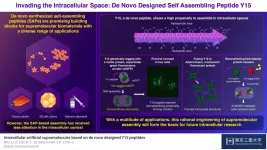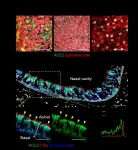(Press-News.org) Imaging spectroscopy can help predict water stress in wild blueberry barrens, according to a University of Maine-led study.
The technology involves measuring the light reflected off of objects depicted in images captured by drones, satellites and other remote sensing technology to classify and gather pertinent information about the objects. According to researchers, it can precisely measure light across dozens, if not hundreds, of bands of colors. The reflectance spectra can depict nutrient levels, chlorophyll content and other indicators of health for various crops, according to researchers.
Scientists from UMaine, the Schoodic Institute and Wyman's, one of the world's largest purveyors of wild blueberries and the number one brand of frozen fruit in the country, found in their research that when incorporated into models, imaging spectroscopy can help predict whether wild blueberry fields will lack sufficient water for growing. Not only can the technology help inform growers as they evaluate irrigation routines and manage their water resources in a way that avoids damaging the crop, researchers say.
The team collected imaging spectroscopy data by deploying a drone equipped with a spectrometer for capturing visible and near-infrared light to photograph wild blueberry fields owned by Wyman's in Debois, Maine. Researchers then processed the images to measure reflected light spectra from the plants for indications of chlorophyll levels and other properties that would help estimate their water potential, which, they say, is the primary force driving water flow and an indicator of water stress. At the same time, the group collected small branches with leaves from wild blueberry plants in the plots to assess their water potential and validate the spectra-based estimation. Pictures and samples were collected in the spring and summer of 2019 when the plants experienced peak bloom, green fruit and color break.
The data from both drone images and ground samples were incorporated into models, which they developed using machine learning and statistical analysis, to estimate water potential, and thereby predict water stress, of the plants in the barrens. Models from the ground sample data were used to help guide the development of and validate the model created with data from the images. The results of both sets of models were comparable, demonstrating that imaging spectroscopy can accurately predict water stress in wild blueberry barrens at different times of the growing season. With the efficacy of the technology confirmed, researchers say scientists can capitalize on the benefits of it, such as conducting repeated measurements on small objects like blueberry leaves with ease.
Graduate student Catherine Chan led the study, joined by UMaine faculty Daniel Hayes and Yongjiang Zhang, Schoodic Institute forest ecologist Peter Nelson and Wyman's agronomist Bruce Hall. The journal Remote Sensing published a report of their findings.
"We couple spectral data and areas of known water potential in wild blueberry fields through machine learning, creating a model to further predict areas that may be water stressed," Chan says.
Understanding how to sustainably manage water resources to mitigate risk associated with current and increasing drought frequency is crucial to wild blueberry growers, researchers say.
"This research provides key learnings to ensure the continued viability of wild blueberry crops for generations to come," Hall says.
Warming and drought exacerbated by climate change have compounded their struggles in recent years, alongside freezing and pathogens. Researchers say as a result, there has been an increased need for predictive tools, like imaging spectroscopy and models that rely on it, for land conditions to inform mitigation strategies.
Nelson says the study was conducted in cooperation with his laboratory of ecological spectroscopy (lecospec) at the Schoodic Institute, which was financed by the Maine Economic Improvement Fund, Maine Space Grant Consortium, the National Aeronautics and Space Administration (NASA) and other University of Maine System funds. The research team used a software he developed with Chan and other students that allows drones and spectrometers to measure light across dozens or hundreds of more bands of color than an average camera, Nelson says.
"We envisioned and continue to promote this as a research and application tool to produce data and algorithms applied to questions and problems in forest, agricultural and marine sectors of Maine's economy," he says.
INFORMATION:
More than 80 percent of people around the world consider themselves to be religious or spiritual. But research on the neuroscience of spirituality and religiosity has been sparse. Previous studies have used functional neuroimaging, in which an individual undergoes a brain scan while performing a task to see what areas of the brain light up. But these correlative studies have given a spotty and often inconsistent picture of spirituality. A new study led by investigators at Brigham and Women's Hospital takes a new approach to mapping spirituality and religiosity and finds that spiritual acceptance can be localized to a specific brain circuit. This brain circuit is centered in the periaqueductal gray (PAG), a brainstem region that has been implicated ...
Over the last two decades, biomaterials research has made significant progress, transitioning from traditional biomaterials to biomaterials with controlled structure and dynamic functionality. A number of building blocks have been explored for developing biomaterials by self-assembly, but SAPs have garnered special attention due to their tunability and potential use in various applications such as tissue engineering, wound healing, and vaccinations. Despite these benefits, the SAP-based approach is less explored in the intracellular context.
Fortunately, a team of scientists from the Tokyo Institute of Technology (Tokyo Tech), led by Assistant Prof. Takayuki Miki, have reported a de novo peptide, Y15, that ...
Boulder, Colo., USA: The Geological Society of America regularly publishes
articles online ahead of print. GSA Bulletin topics include
multiple articles about the dynamics of China and Tibet; the end-Permian
terrestrial extinction paradigm in South Africa; prehistoric lava flows
from the urban district of Catania (Etna volcano, Italy); the debated
origins of granite, and "a tale of two Tweefonteins." You can find these
articles at
https://bulletin.geoscienceworld.org/content/early/recent
.
Authigenic berthierine and incipient chloritization in shallowly ...
Most babies born prematurely or with health problems are quickly whisked away to the Neonatal Intensive Care Unit (NICU) where they might require assisted heating devices to regulate their temperature. A University of Houston College of Nursing researcher is reporting that the traditional use of cloth blankets and towels during peripherally inserted central catheter (PICC) placement may hinder heat transfer from the assisted heating mechanisms, increasing the risk for neonatal hypothermia. In Advances in Neonatal Care, Huong (Kelle) Phan, clinical assistant professor, reports that a plastic drape lowers the incidence of hypothermia.
"The use of the plastic drape is a quality improvement to reduce the hypothermia rate in very low birth-weight ...
WILMINGTON, Del. (June 29, 2021) - A new report finds that 509,025 (9.17%) public high school students in 24 states experienced homelessness in spring 2019 -- three times the number recognized by the states' education agencies. This under-recognition creates gaps in funding and services needed by this vulnerable population.
Researchers from Nemours Children's Health and the University of Pennsylvania analyzed data from the Centers for Disease Control and Prevention (CDC) for public schools across 24 states and 12 school districts. During spring 2019, more than 9% of public high school students experienced homelessness during a 30-day period in the 24 states. The rate was even higher in the 12 school ...
New research published today in the journal Blood Advances finds that certain factors, such as a history of severe pain episodes and coexisting organ conditions, increase the risk of severe COVID-19 illness, including hospitalization, in individuals living with sickle cell disease (SCD). According to researchers, the study results underscore the need for COVID-19 risk reduction strategies and vaccination for this medically vulnerable population.
SCD is the most common inherited red blood cell disorder in the United States, affecting an estimated 100,000 people. According to the Centers for Disease Control and Prevention, SCD affects one out of ...
Understanding how viral infection occurs can provide important clues for researchers to develop strategies to prevent viral transmission and develop effective therapeutic agents and vaccines. SARS-CoV-2, the causative agent of COVID-19, enters the host cells through interaction between the virus's spike protein and the extracellular receptor binding domain of ACE2. The viral entry into the cells is completed by various proteases, which allow the viral and cell membranes to fuse together. While it is known that the upper respiratory tract becomes compromised in the early infection, the exact types of the cells that the virus infects at the earliest stage have not yet been identified.
Led by Director ...
New research from the Institute of Psychiatry, Psychology & Neuroscience (IoPPN) at King's College London, in collaboration with the University of Liverpool and the Karolinska Institute, has shown that many of the symptoms in fibromyalgia syndrome (FMS) are caused by antibodies that increase the activity of pain-sensing nerves throughout the body.
The results show that fibromyalgia is a disease of the immune system, rather than the currently held view that it originates in the brain.
The study, published today in the Journal of Clinical Investigation, demonstrates that the increased ...
Extreme differences in flight altitude between day and night may have been an undetected pattern amongst migratory birds - until now. The observation was made by researchers at Lund University in Sweden in a study of great snipes, where they also measured a new altitude record for migratory birds, irrespective of the species, reaching 8 700 metres.
Great snipes are shorebirds that breed in Sweden, among other places, and spend the winter in areas near the equator in Africa. Previous studies have shown that great snipes make long marathon flights of up to 6 000 kilometres lasting 60-90 hours when they migrate between breeding sites in Sweden and wintering ...
Chatbots have already become a part of our everyday lives with their quick and intuitive way to complete tasks like scheduling and finding information using natural language conversations. Researchers at Aalto University have now harnessed the power of chatbots to help designers and developers develop new apps and allow end users to find information on the apps on their devices.
The chatbot -- 'Hey GUI' (pronounced goo-ee), short for Graphical User Interface, which will be presented at ACM Designing Interactive Systems 2021 on 1 July -- can answer questions by showing images and screenshots of apps, or through simple text phrases.
"Hey GUI eliminates the need for coding skills or technical ...



